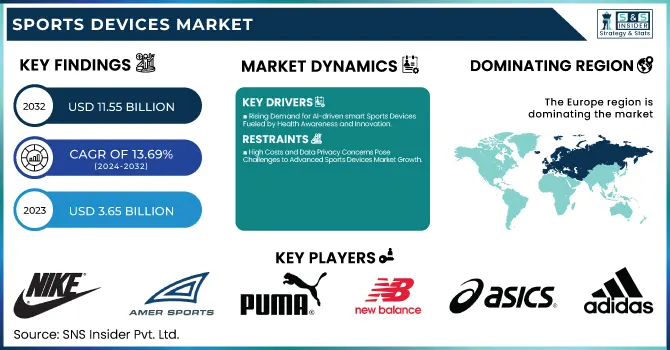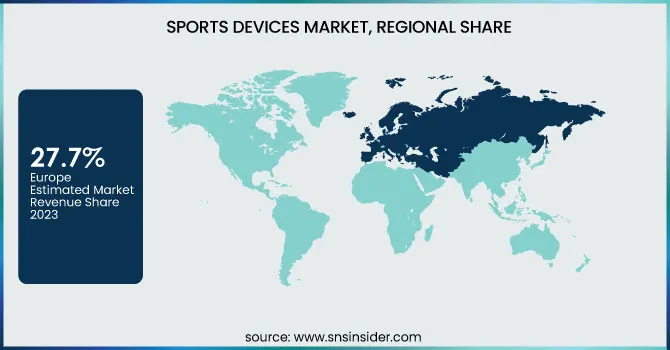Sports Devices Market Size & Growth:
The Sports Devices Market Size was valued at USD 3.65 Billion in 2023 and is expected to reach USD 11.55 Billion by 2032 and grow at a CAGR of 13.69% over the forecast period 2024-2032. The sports devices market is experiencing continuous innovation buoyed by advancements in product capabilities, technological enhancements, and buoyant technology capabilities. Sports gadgets in current times present a greater degree of precision in measuring parameters such as heart rate, caloric intake, journey speed, and intensity, which expands user experience and workout efficiency.

To Get more information on Sports Devices Market - Request Free Sample Report
Ongoing advances in sensor technology, AI-driven insights, and IoT integration are making these solutions more functional and personalized. This drives manufacturers to upgrade product quality and reliability by providing durable designs complemented by extended battery life and seamless connectivity. The use of new technologies, such as biometric monitoring, smart textiles, and real-time data analytics, will continue to help performance optimization and injury prevention create a more personalized workout for each user.
Sports Devices Market Dynamics
Key Drivers:
-
Rising Demand for AI-driven smart Sports Devices Fueled by Health Awareness and Innovation
One of the factors supporting the demand for AI-driven smart sports devices includes the increasing awareness of consumers on health and fitness and the consequent adoption of smart sports & fitness devices such as fitness trackers, smartwatches, and performance monitoring equipment. Demand continues to grow on the back of trends like personalized workout routines and wearable technology. Moreover, improvements in sensors and data analytics have made it possible to track metrics such as heart rate, calories burnt, and movement patterns, adding to the overall user experience and performance feedback. With the increasing applications of IoT (Internet of Things) in sports gadgets, connectivity features are enhanced, from easy pairing to automatic sync with smartphones and fitness apps. Moreover, growing interest in professional sports and a rise in sports infrastructure development are anticipated to further fuel the growth of the market in the coming years.
Restrain:
-
High Costs and Data Privacy Concerns Pose Challenges to Advanced Sports Devices Market Growth
The cost factor in advanced sports devices is one of the main challenges, making it difficult for budget-savvy customers to purchase devices. High pricing of premium devices integrated with new advanced technologies like AI, IoT, and biometric features limit market penetration in a developing region. Furthermore, data privacy and security issues have also become some of the biggest obstacles. While sports devices collect sensitive user data, such as heart rate, location, and workout patterns, a cyberattack or data breach is a real possibility, making consumers hesitate.
Opportunity:
-
AI Integration and VR Solutions Drive Innovation in Sustainable and Fitness Focused Sports Devices
The biggest potential for the integration of artificial intelligence (AI) and machine learning (ML) into sports devices is to use predictive analytics to reduce injuries, improve performances, and provide tailored training advice. E-sports and new virtual reality (VR) training solutions also open up new opportunities for innovation. In addition, the increase in the popularity of environmental and sustainable sports instruments gives gain to manufacturers. Popularity Of Fitness Activities–Increasing disposable income coupled with lesser interest of the population in fitness activities, especially in emerging markets have made them lucrative prospects.
Challenges:
-
Lack of Standardization and Battery Limitations Challenge Growth in Sports Devices Market Expansion
The absence of standardization in devices and platforms is another critical challenge in the sports devices market. An unholy combination of proprietary software and hardware from different brands often spells havoc, creating compatibility problems for users who merely wish to connect their devices with other gadgets and fitness apps seamlessly. And more importantly, battery life limitations in wearable devices are still a problem for athletes that need to track for longer periods. It also struggles a lot to access rural areas with barriers in the form of awareness and affordability. To tackle these challenges, industry participants are innovating cost-effective solutions, promoting a rise in data encryption, and developing seamless battery solutions to strengthen market growth and attain maximum adoption.
Sports Devices Market Segments Analysis
By Component
In 2023, hardware was the dominant segment with a share of 59.8% in the sports devices market, fueled by the adoption of fitness trackers, smartwatches, and performance monitoring equipment, as reflected in a recent report by, Techsci Research. The rising popularity of professional sports training combined with improved wearable technologies was another major factor in the high market share of hardware. Demand for hardware-based tools was further driven by increasing consumer interest in tracking performance and health in real-time.
The software segment is to grow the fastest CAGR between 2024 to 2032. This boom is due to the seepage of AI, ML, and data analytics in sports applications. Software solutions are providing better user experiences through personalization that incorporates training insights, injury prevention, and performance optimization into one easy platform. Software segment growth will also be propelled by the rising adoption of interactive fitness apps and virtual coaching platforms.
By Device
The digital signage segment held the largest share in the sports devices market in 2023 at 33.9% share, as the segment is widely used in stadiums, fitness centers, and sports events. Digital signage solutions are an integral part of increasing audience engagement, delivering real-time updates and information like scores, ads, player statistics, etc. The proliferation of new interactive displays and sophisticated content management systems was also key to its proliferation.
The wearables segment is expected to record the fastest CAGR from 2024-2032. This increase is driven by consumer demand for fitness trackers, smartwatches, and smart clothing to measure health and performance metrics. From developing biometric sensors, and AI-based insights to offering personalized fitness solutions the continuous innovations in wearable sports devices are also speeding up their adoption, which makes it one of the leadership forces of future market growth.
By Deployment
In 2023, the on-premise segment accounted for 59.6% of the market share in the sports devices market due to its high security, heightened control of data, and reliability. The on-premise solution is a part of the top sports technology trends as it is preferred by several sports organizations, stadiums, and fitness centers needing real-time data processing and higher privacy. These solutions are more customized and the control over data is stronger, which truly is a perfect fit for the management of large-scale sports events and training programs.
The cloud segment is anticipated to experience the highest CAGR from 2024-2032. Cloud adoption has been increasing, driven by the need for scalable, flexible, and cost-effective solutions. The cloud-based platforms allow easy data access from anywhere, and enable remote monitoring and real-time analytics, resulting in better performance tracking of athletes and improved fan engagement. The increasing investment in AI-enabled sports analytics and fitness applications continues to propel the cloud in the sports devices market.
By Sport
In 2023, football was the largest segment in the sports devices market with a market share of 22.6%. The scale of this dominance was a direct result of the international appeal of the sport, especially in parts of the world like Europe, North America, and South America. Advanced performance tracking devices, GPS-enabled wearables, and video analysis tools are widely exploited in football to monitor athletes' performances, prevent injuries, and devise effective strategies. Moreover, increasing investment in football leagues and clubs also bolstered this segment’s growth.
Cricket will grow with the fastest CAGR from 2024-2032, mainly due to the increased number of fans worldwide and the technology adopted for training and match analysis. Demand for cricket smart wearables for performance monitoring, injury prevention, and recovery is driving growth in smart cricket gear of different types, including motion sensors and video analytics.
Sports Devices Market Regional Analysis
Europe held the major share in the sports devices market with a 27.7% share in 2023 This expansion was mainly due to the region's sports culture and infrastructure, coupled with a growing adoption of smart sports technology. Germany, the UK, and France have made significant investments into championship leagues, particularly in professional sports, leading to an increased demand for performance-tracking devices and digital signage within stadiums. Take, again, Premier League, in which clubs splash on using GPS trackers, heart rate monitors, and video analytics for improved performance and reduced injury risk. Likewise, the Tour de France makes use of advanced fitness wearables and data-driven insights into how athletes cope with endurance factors of the body, which allows them to devise the best strategies for accomplishing the racing event.
Middle East & Africa region held the fastest CAGR throughout 2024-2032 owing to increasing investment for sports infrastructure and increasing penetration of fitness activities. Qatar with FIFA World Cup 2022, Saudi Arabia with golf tournaments, and UAE with Dubai Fitness Challenge are among the countries promoting sports these days. Furthermore, increasing usage of smart wearables and real-time tracking devices among sports facilities in this area to boost athlete performance and offer fitness enthusiasts a seamless experience is further accelerating the demand for smart sports market expansion.

Get Customized Report as per Your Business Requirement - Enquiry Now
Key Players
Some of the major players in the Sports Devices Market are:
-
Nike (Air Max Sneakers)
-
Adidas (Predator Football Boots)
-
Amer Sports (Salomon XT-6 Trail Shoes)
-
Puma (Future Z Football Boots)
-
Under Armour (Curry Basketball Shoes)
-
New Balance (990v5 Running Shoes)
-
Lululemon Athletica (Align Yoga Pants)
-
Athleta (Salutation Stash Pocket Tights)
-
Avery Dennison (Embelex Branding Solutions)
-
Asics (Gel-Kayano Running Shoes)
-
Technogym (MyRun Treadmill)
-
Salomon Group (Speedcross Trail Running Shoes)
-
Butterfly (Tenergy Table Tennis Rubbers)
-
Decathlon (Quechua Tents)
-
Net World Sports (FORZA Football Goals)
Recent Trends
-
In July 2024, Nike and Hyperice unveiled a revolutionary wearable device combining performance tracking with recovery technology, offering real-time insights and enhanced muscle recovery for athletes.
-
In November 2024, Accenture teamed up with PUMA India to create an advanced supply chain network, leveraging digital technologies to enhance efficiency, inventory management, and customer experience.
| Report Attributes | Details |
|---|---|
| Market Size in 2023 | USD 3.65 Billion |
| Market Size by 2032 | USD 11.55 Billion |
| CAGR | CAGR of 13.69% From 2024 to 2032 |
| Base Year | 2023 |
| Forecast Period | 2024-2032 |
| Historical Data | 2020-2022 |
| Report Scope & Coverage | Market Size, Segments Analysis, Competitive Landscape, Regional Analysis, DROC & SWOT Analysis, Forecast Outlook |
| Key Segments | • By Component (Hardware, Software,) • By Device (Wearables, Digital Signage, Camera) • By Deployment (On-premise, Cloud) • By Sport (Football, Cricket, Baseball, Basketball, Rugby, Others) |
| Regional Analysis/Coverage | North America (US, Canada, Mexico), Europe (Eastern Europe [Poland, Romania, Hungary, Turkey, Rest of Eastern Europe] Western Europe] Germany, France, UK, Italy, Spain, Netherlands, Switzerland, Austria, Rest of Western Europe]), Asia Pacific (China, India, Japan, South Korea, Vietnam, Singapore, Australia, Rest of Asia Pacific), Middle East & Africa (Middle East [UAE, Egypt, Saudi Arabia, Qatar, Rest of Middle East], Africa [Nigeria, South Africa, Rest of Africa], Latin America (Brazil, Argentina, Colombia, Rest of Latin America) |
| Company Profiles | Nike, Adidas, Amer Sports, Puma, Under Armour, New Balance, Lululemon Athletica, Athleta, Avery Dennison, Asics, Technogym, Salomon Group, Butterfly, Decathlon, Net World Sports. |

